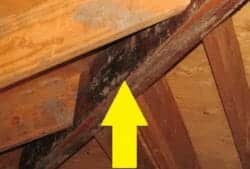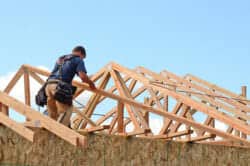Is wood shrinkage causing drywall cracks and structural damage to your house?
Home » Structural » Framing »

Wood shrinkage and the moisture content of wood can cause a number of problems for homeowners and builders: including drywall cracks, structural issues and even health problems. Whether in a new home or an older home. Few homeowners ever think about this or know what to do.
Smart homeowners need to know about these problems. The problems include:
- Structural problems
- Drywall cracking, creaking sounds and other issues
- Wood rot issues
- Mold and Health issues
- Seasonal changes
In general wood shrinks when the moisture content goes down and expands when the moisture content goes up. The amount depends on a number of factors, such as, the type of wood, if it’s new green lumber from a freshly cut tree, if it’s seasoned wood, the relative humidity and the temperature, just to mention a few. When building a house there are various building codes that regulate what type of wood may be used, whether it’s kiln dried, green or seasoned and what the moisture content is.
Knowing the warning signs of wood shrinkage, the damage it can cause and what you can do about it if caught early may save you from having problems in the future and allows you to be proactive.
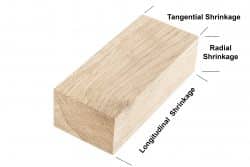
Wood Shrinks in 3 Directions
Engineers, framers and contractors know that wood shrinks in three different directions.
- Radial Shrinkage
- Tangential Shrinkage
- Longitudinal (very little shrinkage)
Wood usually shrinks when it dries and expands when it gets wet, both of which can cause minor to serious problems in a home.
If minor or moderate
On the minor to moderate side, it may cause hairline cracking in the drywall and in a few instances, drywall cracks that are an 1/8th or a 1/4 inch wide; stairs might creak, handrails may be slightly wobbly, the floor may creak in areas, etc. On the major side it can cause structural issues, leaking issues (at roof jacks, vents and flashing areas) plus problems with walls, ceilings and other components of the home.
The good news is that the majority of time, shrinkage usually causes minor issues, not major ones.
If you think of an 8 foot long 2 x 4 you might think of the 1 ½ inch side as the Radial shrinkage side; the 3 ½ inch side as the Tangential shrinkage side and the 8 foot length as the Longitudinal shrinkage.
A rough rule of thumb is that the Tangential Shrinkage is about 2 times that of the Radial Shrinkage and that Longitudinal Shrinkage is very, very little. The amount of shrinkage varies according to the moisture content of the wood, the type of wood, and the temperature and humidity of the home.
Basically, wood moisture content levels in a home will over time reach an equilibrium level of its environment. In damp and high humidity environments wood will have a much higher moisture content, than it will in dryer environments with low humidity levels.
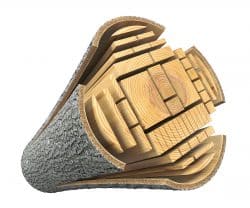
Lumber in your home – what’s the moisture content?
When lumber is first delivered to a construction site for building a home or a remodeling project, it may have a moisture content of 15% to 19%, and often higher; it is not unusual for it to be above the 19% level when non-kiln dried lumber is delivered (which is often much of the lumber used in building a new home). Kiln dried lumber often arrives with a moisture content around 13% to 15% moisture content, give or take, depending on the time of year and the part of the country that you live in.
Over time the moisture level of framing lumber tends to level out
The moisture content of framing lumber will generally stabilize between 8% to 12% over time in most homes. Cabinet and furniture makers will generally use wood that has a moisture content of 7% to 8 % so as to avoid most shrinkage problems.
Structural issues
When lumber dries it usually shrinks which can cause both cosmetic and structural issues. Engineers have established moisture content guidelines and requirements for how much moisture can be in various wood components of a home when it is being built. Additionally, the building code has specific requirements about lumber that is being used to meet certain structural needs, as well as, allowable limits for lumber that will be covered by drywall.
Shrinkage may cause loose connections which is a structural problem
As wood shrinks, metal fasteners and connectors may loosen, thus joints and connections may not be structurally as strong as they were designed for. As wood shrinks, the dimensional aspects of the wood usually change; this can weaken connection points in a structure.
Too high of moisture content may cause corrosion and rust of metal fasteners
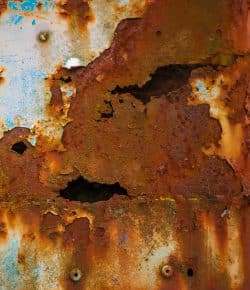
A high moisture content in lumber may cause a number of structural issues in a home. If the level of moisture in lumber is too high the lumber may lose part of its structural strength and even have a long-term effect on the structure itself. Not only will dimensional lumber have issues, but products like plywood and OSB Board can suffer loss of strength.
When metal fasteners corrode, the connection strength between structural joints and other connections can be significantly affected over time.
Additionally, if lumber has too high of moisture content, then metal hardware and connectors (including nails and screws) may corrode and loose strength. In some cases, if the moisture content is over 20%, a nail shank may loose 5% of its diameter in 4 or 5 years and much more over long periods of time. Corroded hardware and connectors are a serious concern from a structural standpoint.

A hump in the floor
Have you ever walked across a floor and noticed that there is a little hump in the floor? If so, one of the many causes may be related to wood shrinkage. One of these is that there may be a structural beam under the floor that is supporting the end of the floor joists connected to the beam.
If the beam is made of “Laminated veneer lumber (LVL),” basically an engineered wood product, such as a glue lamb beam, it will not shrink dimensionally. However, if the joists connected to it are dimensional lumber, such as, 2 x 10’s or 2 x12’s, then they may shrink 1/8 to 3/8 of an inch, from when they were first installed or connect to the beam, in the first year.
This shrinkage of the joist, but not the LVL beam, can result in a hump in the floor over time, amounting to a 1/8 to 5/16 of an inch. This is normally not considered a structural concern but more of a design or poor framing practice.
The building code
In most states and localities, the building departments will not allow wood framed walls and ceilings to be covered with drywall or other coverings unless the moisture content is 19% or lower. Part of the reason for this, deals with mold growth, decay and possible wood rot. Another reason deals with metal fasteners and structural connections.
Drywall cracking and wood trim
One of the most common results of wood shrinkage, especially in new homes, is for cracks to appear in the drywall. The cracks are caused by the wood shrinking and occasionally by the wood expanding. When homes are first built, a fair amount of lumber has higher than normal moisture content and when it dries out over time cracks appear. Especially at door and window headers and corners, as well as, wall open areas where there is a large header. The majority of these cracks will be hairline cracks, but a few may be an1/8 inch or larger. The larger the crack the more of a concern the crack becomes. (Read more about drywall cracking )
Wood trim
- Baseboard
- Crown Molding
- Door and window casing
Homeowners will often notice wood trim that has gaps at joints and corners or has warped or swelled and they think in their mind it’s just poor workmanship. Sometimes this is true, but often it is due to moisture changes in the wood.
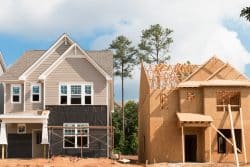
Drywall cracks in new homes
In new homes that are less than one or two years old, it is not uncommon for hairline cracks to develop in a few locations.
These cracks are usually less than a 1/16 of an inch wide, often caused by wood shrinkage and generally not of a major concern or a structural issue; however, under a few circumstance cracks in the drywall of a new home can be a “Red Flag” that there is something serious and should be further examined.
3. If moisture levels are too high, then “Wood Rot” may develop

If wood has a high moisture content over an extended period of time, wood rot may set in, as well as termite issues; thus, the structural strength of the wood becomes compromised.
Building with wood that is wet and has a very high moisture content may result in dry rot; especially if there is a continual source of moisture from plumbing or roof leaks.
Note that there some types of termites that survive and grow well in damp wood, resulting in more wood damage. Remember that if termites are suspected or frass (termite droppings) or tunnels are noted, a pest control company should be consulted and in instances where there is severe damage, possibly a structural engineer. (Read more about wood rot)
4. Health Issues & Mold and mildew
Mold and mildew often pose health risks. If the moisture content of wood in a home is too high, mold and mildew may develop due to the high moisture content of the wood.

This type of issue may arise when the lumber delivered to build a home has a high moisture content or was exposed to wet and damp weather for a period of time during the construction process and especially if the wood framing members in the walls and ceilings were covered, i.e. with drywall, before the lumber dried out or had a moisture content of under 19%. Also, plumbing leaks, flashing issues and roof leaks may contribute to this problem. (Read more about mold and mildew)
Humidity levels
In a few circumstances mold may develop when the humidity level is 55% to 60% and at higher levels of 70% or higher, it can easily develop. To keep from developing mold, one of the things a homeowner can do is to have a hygrometer, so that they will know what the temperature and humidity level of their home is.
Should there be periods where the humidity level is too high, then it should be reduced and at times a dehumidifier will be helpful in accomplishing this.
5. Seasonal changes often affects the moisture content of wood in a home

In the winter the relative humidity of a home may get down under 30% and in the summer with the windows open it may reach those of the outdoors which may be 70% to 80%. This, in the winter heating season, may result in some wood or wood components having a moisture content as low as 4% and in the summer months, reach as high as 16%.
Large swings in temperature and humidity can have significant effects on various components and systems in a home. It may cause drywall cracks to open and close, stair parts to loosen or become wobbly and wood flooring to develop gaps, cup or creak.
Moisture issues in a home when related to seasonal changes in temperature and humidity, may also cause:
- Truss up-lift
- Mold and mildew / health issues
- Bathroom vent issues
- Gapping or bowing of wood trim
Laminate flooring issues
Seasonal changes with significant humidity and temperature changes may cause laminate flooring to expand and contract. It may develop gaps between the planks and at other times swell or look like it has a crown in it. In winter months the planks may appear to have wider gaps or spaces between them and in the summer months the gaps tighten up; sometimes bowing, crowning or the floor may look like it is rising up with some planks moving downward a little when stepped on.
Yellow flags of wood shrinkage
- Drywall cracks especially at header areas of doors and windows
- Nails heads popping out
- Truss up-lift (Read about truss up-lift)
- Floors creaking (More on floors creaking)
- Stairs creaking or other creaking sounds in the home
- Leaks at plumbing stacks; often evidenced by stains on drywall or moisture in the attic (this is rare)
- Leaks at flashing points; often evidenced by stains on drywall or around windows
- A hump in the floor that wasn’t there when the home was first built
Homeowners and many contractors often overlook the problems or issues that are created by wood shrinkage, fortunately it generally does not cause major damage to a home in most circumstances. Even though this is true, homeowners should be aware of it and have a basic knowledge about it, for occasionally it can cause structural damage and can be related to other issues in a home; such as creaking sounds and health issues from mold.
Understanding moisture issues and keeping the humidity and temperature of a home in-check will help reduce many of the problems associated with the moisture content of wood and wood shrinkage.



